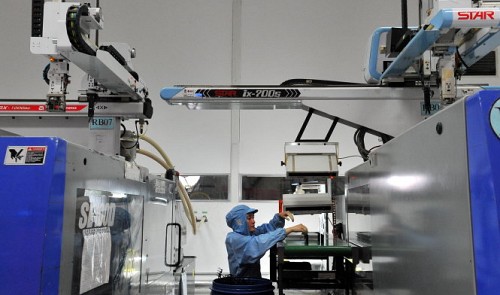Editor’s note: Do Huyen Trang, a 20-year-old woman from Hanoi, joined the “Ky Vong Viet Nam 20 Nam Toi” (“My Expectations for Vietnam in 20 Years”) writing contest with a dream that Vietnamese people’s productivity would rival their regional counterparts in 2035.
As a young citizen, I aspire that in the next 20 years, Vietnamese people’s productivity would be elevated from its current humble position compared to other countries in the region now.
According to the International Labor Organization, Vietnamese people’s productivity in 2013 was rather low as compared with other countries from the Association of Southeast Asian Nations (ASEAN), and bottomed compared to Asian-Pacific countries. Vietnamese workers’ productivity is one-fifth of Malaysians’, two-fifths of Thais’ and one-fifteenth of Singaporeans’.
Dreaming of a quality labor force
The undesirably low productivity can be put down to several reasons, including limited technological knowledge, a low rate of skilled workers in proportion to those receiving vocational training, and a lack of soft skills for global integration. The reality is not very good. However, as Vietnam is on its way to development, we have the right to expect a brighter future in the next two decades.
I desire that in 2035, Vietnamese workers’ productivity would rank among the top in Southeast Asia. Outdated, simple processing tasks in Vietnam would occupy a small proportion and be replaced with hi-tech jobs which are assisted by cutting-edge machinery and international-standard processing phases.
Workers would not only boast excellent professional expertise and manipulate machinery with ease, but also be confident and bold while negotiating with their partners. Vietnam would then possess a labor force which investors find hugely tempting not because of cheap costs, but for high quality and affordable costs.
Enhanced productivity and effective labor force allocation would also help solve most of the tricky problems from 20 years earlier, including outlets for workers, enterprises lacking skilled workers or prolonged unemployment.
In the next 20 years, Vietnam would brilliantly accomplish its targets of modernization and industrialization and become a real industrialized country thanks to efforts in improving productivity. It would also serve as a shining example for developing countries to follow.
Things that need to be done right now
For this promising prospect to turn true, numerous tasks need to be done right now. Challenges will be overwhelming in the context of the establishment of the ASEAN Economic Community by the end of this year. Following the establishment and Vietnam’s entry into the community, highly skilled employees will migrate freely from one ASEAN country to another. But for efforts to boost local workers’ productivity right now, they will fail to compete with the imported human resources and may lose the market right on their home ground.
First, as productivity depends largely on the level of enterprises and the country, the state should make a point of adopting hi-end technological advances, enhance value added, and make investing in auxiliary industries a priority. Today, to keep pace with regional countries and the world’s technological advances, the speed of renovating our production technology is supposed to reach approximately 20 percent per year.
A handful of the solutions currently implemented by the state include boosting investment in scientific research and inventions to beef up productivity; cutting down on the rate of manual work in phases; stepping up cooperation and technology transfers with developed countries; inviting experts to Vietnam to train local staff; and sending local personnel to other countries for studies.
In addition, a need also arises for technology transfer among localities across the country, as Vietnam currently sees a vast discrepancy regarding productivity and technological levels.
Second, it’s advisable that investment be made in education and training. One of the local work force’s minuses is the low rate of trained and skilled workers. A large number of graduates from vocational schools fail to meet enterprises’ requirements.
Faced with these challenges, sound changes in teaching and learning should be carried out at universities and vocational schools so that graduates would meet local and global demands. Instead of training students separately, educational facilities also need to coordinate with businesses, and add practice to their curricula, so as to reconcile what is learned at schools with what is actually required at businesses and duck the scenario in which graduates must be retrained anew before they can work well at companies. Education leaders are also supposed to attach international standards to the training process and prepare students for international working environments.
Soft skills are also a sound addition to the training of the work force. Such skills include communicating at the workplace in a foreign language with foreigners, working in groups, and negotiating and debating fruitfully. These soft skills cannot be acquired overnight, but need to be honed in reality.
Schools thus need to incorporate skill subjects into the curricula along with professional subjects. They should also hold sessions in which students’ skills are challenged in order to assess their problem solving and decision making capacity. Members of the work force also need to update themselves on knowledge, expertise, skills and current market demands to make themselves an irresistible choice for recruiters.
Last of all, awareness education should also receive due attention. One of the reasons behind Vietnamese workers’ low productivity is their inadequate working attitudes, including lack of punctuality, ambition, and eagerness to learn. To remedy this, local workers’ awareness should be raised via education. Penalties and rewards should be applied to violators and outstanding performers as well.
|
“Ky Vong Viet Nam 20 Nam Toi” is a competition organized by the World Bank in Vietnam and Tuoi Tre (Youth) newspaper that encourages local youths to write down their wildest, yet feasible, dreams about how Vietnam will change in 20 years’ time. |






















































